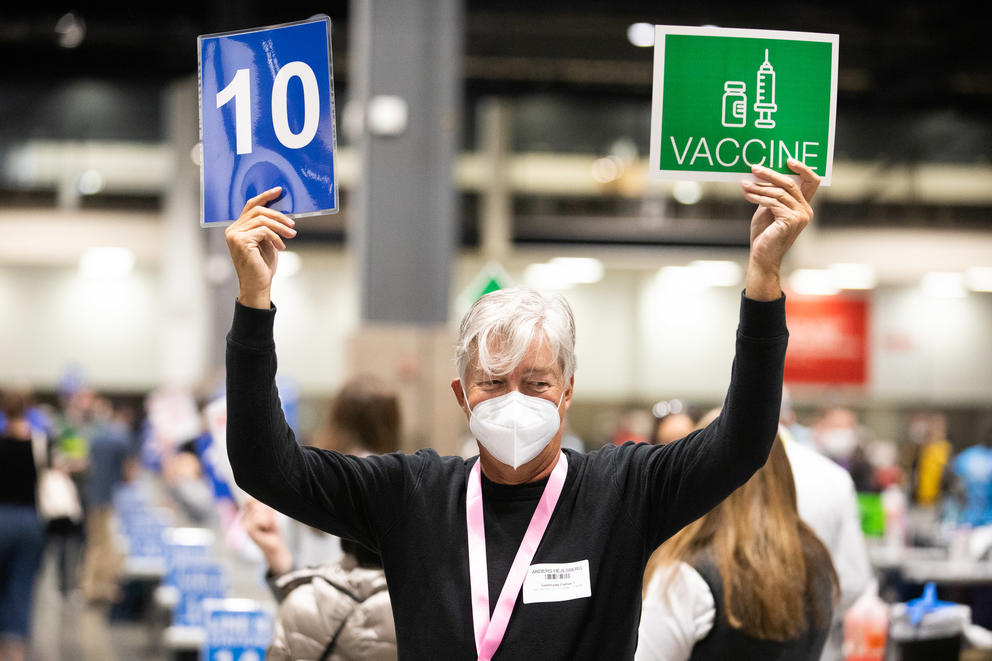In Washington state, as in other parts of the country, Latino and Black communities have been disproportionately impacted by the coronavirus. While 13% of the Washington population is Latino, about 31% of people who have had the coronavirus statewide identified as Latino. About 5% of coronavirus cases affected Black people, who make up 4% of the state’s population.
With regard to those 65 and over, one of the first groups eligible for the vaccine in Washington state, 4% identify as Latino; 3% have been vaccinated, according to Washington State Department of Health data. Meanwhile, 2% of those who are over 65 are Black; 1% have been vaccinated.
Other data on vaccines by race offers a mixed picture. Asians, for example, represent about 7% of the population and 6% of those vaccinated so far.
While Native Hawaiians and Pacific Islanders make up less than 1% of the Washington state population, their share of vaccines distributed so far is slightly higher than their share of population, with 2,521 people from these groups receiving at least one vaccine out of a population of about 80,000 people.
Native Americans represent about 1% of Washington's population and about 1% of those vaccinated so far.
Experts say it is important to keep in mind that the reason the disparities may not be as evident when looking specifically at the population over 65 is because life expectancy is shorter in certain communities, such as among the Black population, because of broader systemic inequities that can leave individuals struggling to get good health care.
“These inequities existed before COVID-19 and have been amplified by the pandemic,” said Kristen Maki, a public information officer with the Department of Health.
The disparities in vaccination rates become more apparent when looking at the overall state population, regardless of age. Vaccination rates among people of any age show that only 5% of those who are Latino have been vaccinated, even though they represent 13% of the population. And only 2% of those who are Black have been vaccinated despite representing 4% of the population. These percentages include people who are too young to be vaccinated.
Those statistics come with another caveat: 7% of people over 65 and 8% of the general population are either not reporting their race or ethnicity, or their provider, for whatever reason, has not passed on that information to the state. Maki said the percentage of people who categorize themselves as “other race” — 13% of all vaccinated people who provided this type information have identified themselves this way — also complicates matters.
Morales said it’s difficult to know whether this missing data is more likely to include communities of color.
“If they are truly being undercounted, because they're less likely to report, then the gaps are not as big,” Morales said.
Individual vaccine providers submit race or ethnicity data to the state in a number of ways. For the mass vaccination sites in south King County, for example, patients are asked to self-report their race or ethnicity when scheduling an appointment. They can also decline to provide this information. If the data is missing when they arrive at their appointment, clinic staff will once again try to collect that information, said Kate Cole of Public Health — Seattle & King County.
Kelsey Nyland, a spokesperson for Mayor Jenny Durkan, said patients vaccinated by the city can provide the information when registering for the vaccine, sometimes with the help of community partners.
Other providers, such as community health centers and individual doctors, may already have race or ethnicity information of their patients on file.
Maki said the state Department of Health is actively reaching out to all providers who send a high percentage of patient records with missing race or ethnicity information, but could not name the specific facilities.
Looking forward, Morales said inequities in vaccination rates may change because some of the first workers to be eligible for the vaccine skew white, including health care workers and teachers, while upcoming groups like agriculture and grocery workers include a higher percentage of nonwhites.
“So it's important to quickly move to essential workers who are going to be disproportionately nonwhite...and that will change things,” he said.
Morales said he would have preferred to use risk of infection as the indicator for priority vaccination.
“If you look at infection rates among different groups of employees, essential workers are probably the highest at risk of any group, more so than doctors or nurses, and more so than teachers,” Morales said.



